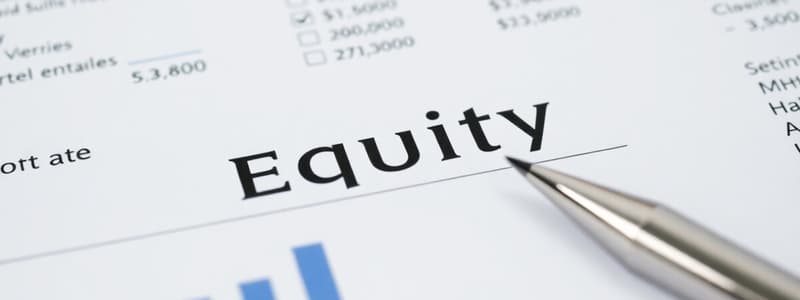Podcast
Questions and Answers
Which of the following statements is not a primary reason for public limited companies to publish their financial statements?
Which of the following statements is not a primary reason for public limited companies to publish their financial statements?
- To comply with legal requirements.
- To enable stakeholders to make informed decisions.
- To allow users to review the company's historical performance.
- To minimize the company's tax obligations. (correct)
The statement of cash flows is regulated by International Accounting Standard (IAS) 3.
The statement of cash flows is regulated by International Accounting Standard (IAS) 3.
False (B)
In the statement of profit or loss, where are detailed workings for the cost of sales typically performed?
In the statement of profit or loss, where are detailed workings for the cost of sales typically performed?
notes to the financial statements
According to the provided content, profits on the sale of PPE and gains on revaluation of property are classified as ______.
According to the provided content, profits on the sale of PPE and gains on revaluation of property are classified as ______.
Match the following categories with their placement in the Statement of Profit or Loss and Other Comprehensive Income:
Match the following categories with their placement in the Statement of Profit or Loss and Other Comprehensive Income:
Why is it important to classify gains on revaluation of assets as 'Other Comprehensive Income' rather than including them in operating profit?
Why is it important to classify gains on revaluation of assets as 'Other Comprehensive Income' rather than including them in operating profit?
In real-world accounting, other comprehensive income is typically combined with realized incomes on the statement of profit or loss.
In real-world accounting, other comprehensive income is typically combined with realized incomes on the statement of profit or loss.
List three common components of equity that are presented in the statement of changes in equity.
List three common components of equity that are presented in the statement of changes in equity.
The statement of financial position reflects the accounting equation: Assets = Equity + ______.
The statement of financial position reflects the accounting equation: Assets = Equity + ______.
Match the following items with their classification in the statement of financial position:
Match the following items with their classification in the statement of financial position:
Which of the following is the correct order of listing current assets in the statement of financial position?
Which of the following is the correct order of listing current assets in the statement of financial position?
A transfer between income surplus and general reserve affects the total equity of the company.
A transfer between income surplus and general reserve affects the total equity of the company.
What does operating profit represent?
What does operating profit represent?
In the statement of changes in equity, net profit after tax is ______ to the income surplus.
In the statement of changes in equity, net profit after tax is ______ to the income surplus.
Match the following with their descriptions.
Match the following with their descriptions.
During the year, a company's equipment depreciated and they sold a building at a gain. How are gains and losses on revaluation of assets presented?`
During the year, a company's equipment depreciated and they sold a building at a gain. How are gains and losses on revaluation of assets presented?`
Income directly related to the company's operations should be excluded from income.
Income directly related to the company's operations should be excluded from income.
Where does the statement of changes in equity obtain the closing balances for items of equity?
Where does the statement of changes in equity obtain the closing balances for items of equity?
IAS 38 covers ______ non-current assets.
IAS 38 covers ______ non-current assets.
Match each of the following accounts with its category on the Balance Sheet:
Match each of the following accounts with its category on the Balance Sheet:
Flashcards
Published Accounts
Published Accounts
Financial reports public companies must publish, enabling stakeholders to assess performance and make decisions.
Statement of Profit or Loss and Other Comprehensive Income
Statement of Profit or Loss and Other Comprehensive Income
Shows a company's financial performance over a period.
Statement of Changes in Equity
Statement of Changes in Equity
Illustrates how stockholders' equity changes over time.
Statement of Financial Position
Statement of Financial Position
Signup and view all the flashcards
Notes to the Financial Statements
Notes to the Financial Statements
Signup and view all the flashcards
Sales Revenue
Sales Revenue
Signup and view all the flashcards
Cost of Sales
Cost of Sales
Signup and view all the flashcards
Gross Profit (or Loss)
Gross Profit (or Loss)
Signup and view all the flashcards
Other Income
Other Income
Signup and view all the flashcards
Other Comprehensive Income
Other Comprehensive Income
Signup and view all the flashcards
Profit on Sale of PPE
Profit on Sale of PPE
Signup and view all the flashcards
Gain on Revaluation of Property
Gain on Revaluation of Property
Signup and view all the flashcards
Operating Profit
Operating Profit
Signup and view all the flashcards
Total Comprehensive Income
Total Comprehensive Income
Signup and view all the flashcards
Statement of Changes in Equity
Statement of Changes in Equity
Signup and view all the flashcards
Accounting Equation
Accounting Equation
Signup and view all the flashcards
Assets
Assets
Signup and view all the flashcards
Liabilities
Liabilities
Signup and view all the flashcards
Equity
Equity
Signup and view all the flashcards
Property, Plant, and Equipment (PPE)
Property, Plant, and Equipment (PPE)
Signup and view all the flashcards
Study Notes
Final Accounts for Publication (Published Accounts)
- Public limited companies are legally required to publish their financial statements.
- These statements allow users to review the company's performance and make informed decisions.
Statements to be Prepared
- Statement of Profit or Loss and Other Comprehensive Income
- Shows the profitability and financial performance of the company.
- Statement of Changes in Equity
- Illustrates the movement in stockholders' equity over a specific period.
- Statement of Financial Position
- Reflects the liquidity and overall financial standing of the business.
- Statement of Cash Flows
- Regulated by International Accounting Standard (IAS) 7.
- Notes to the Financial Statements
- Provide detailed workings and explanations supporting the figures in the main statements.
- Considered organized workings for exam purposes
Focus of the Video
- The video will concentrate on the first three statements and the notes to the accounts.
- The goal is to provide formats and explain key concepts for preparing these statements.
- The approach taken will be tailored for exam preparation, but also relevant to real-world application.
Statement of Profit or Loss and Other Comprehensive Income
- This statement has evolved from the traditional trading profit or loss account (or income statement).
- International Financial Reporting Standards (IFRS) require it to be called the Statement of Profit or Loss and Other Comprehensive Income.
- The statement will be highly summarized, necessitating detailed workings in the notes to the financial statements.
Presentation Format
- Use the appropriate currency sign (e.g., dollars).
- Include "Notes" column to reference the corresponding workings in the notes to the financial statements.
- Revenue (or Sales Revenue) is the starting point.
Sales Revenue
- If adjustments or workings were performed on the revenue figure, indicate the relevant note number.
- Example: If the revenue calculation is detailed in note 1, place "1" in the "Notes" column next to the revenue figure.
Cost of Sales
- Cost of Sales is deducted from Revenue.
- All detailed calculations (e.g., opening inventory, purchases, closing inventory) are performed in the notes, not on the face of the statement
- Indicate the relevant note number in the "Notes" column.
- The cost of sales is shown in brackets
Gross Profit or Loss
- Calculated by subtracting Cost of Sales from Revenue.
Other Income
- Only include income that is realized and directly related to the company's core operations.
- Exclude incomes that are not truly realized, are imaginary, or not directly related to the company's primary activities.
- Such incomes are classified as "Other Comprehensive Income".
- Examples of other comprehensive income include
- Profits on the sale of PPE (Property Plant and Equipment).
- Gains on revaluation of property.
Profit on Sale of PPE (Example)
- An asset was bought for $400 with a 5-year useful life ($80 annual depreciation).
- After 3 years, accumulated depreciation is $240 ($80 x 3)
- The carrying amount (or net book value) is $160 ($400 - $240).
- If the asset is sold for $200, the apparent "profit" is $40 ($200 - $160).
- It's debatable because you bought it for 400 which means you made a loss of 200 instead
Why Profits on Sale of PPE is Considered Other Comprehensive Income
- The "profit" is subjective and depends on depreciation estimates.
- It is not a reliable indicator of the company's core operating performance.
Gain on Revaluation of Property
- Represents an increase in the value of an asset based on revaluation.
- This gain does not involve actual cash inflow or realized profit.
- Therefore, it is classified as "Other Comprehensive Income".
Impact on Director Bonuses
- Including unrealized income in operating profit can inflate the profit figure.
- Many directors are paid bonuses based on the net operating profit.
- Including items such as gains on revaluation of assets can artificially inflate the director's bonuses.
- This is because those items are not true business profits.
- Classifying these gains as "Other Comprehensive Income" prevents inflated bonus payouts.
Comprehensive Income and Profit Calculation
- Fictional or unrealized profits can deceive a company about its true financial performance.
- Other comprehensive income items are not included in the calculation of gross profit or operating profit.
- Net profit is estimated by adding realized other incomes.
- Other comprehensive income is presented separately on the financial statements.
- Total comprehensive income is the sum of the net profit and other comprehensive income.
- Gains or losses on revaluation of property, sale of PPE, and fair tax adjustments are included in other comprehensive income.
- In exam scenarios without a separate requirement for other comprehensive income, these items may be included in the statement of profit or loss.
- In real-world accounting, other comprehensive income is typically separated from realized incomes.
Format of the Statement of Profit or Loss and Other Comprehensive Income
- After gross profit or loss, other realized income is added.
- This other income could include investment income and other company-specific realized incomes.
- Operating expenses are grouped into administrative and general expenses and selling and distribution expenses.
- Administrative and general expenses and selling and distribution costs are subtracted from the sum of gross profit and other income.
- The resulting figure is the operating profit.
- Operating profit represents profit from operations, excluding other comprehensive income.
- Operating profit can also be referred to as net profit before interest and tax.
- Interest expense is then subtracted from the operating profit.
- The resulting figure is the net profit before tax.
- Net profit before tax less tax expense for the year results in net profit after tax.
- Tax expense for the year is calculated, considering current tax, prior adjustments, and movement in deferred tax.
- After net profit after tax, other comprehensive income is added.
- Common other comprehensive income items include profit or loss on the sale of PPE and gain or loss on revaluation of property.
- Deferred tax implications may also be considered.
- The final figure after adding other comprehensive income to net profit after tax is the total comprehensive income.
- The statement of profit or loss and other comprehensive income is presented in two parts: the statement of profit or loss and other comprehensive income.
Format of the Statement of Changes in Equity
- The statement of changes in equity shows the changes in equity items over a period.
- Components of equity include share capital (stated capital), retained earnings (income surplus), share deals, revaluation or capital surplus, and reserves like general reserve.
- The format includes columns for each equity item, narration, and a total column.
- The statement begins with the balance brought forward for each equity item.
- Changes in each equity item are then analyzed and recorded.
- Changes in stated capital may result from issuing new shares.
- The item that will change the most is the income surplus or the retained earnings
- Net profit after tax is added back to the income surplus.
- Dividend payments are subtracted from the income surplus.
- Transfers can occur between income surplus and other reserves.
- Transfers do not affect the total.
- Capital surplus changes are due to revaluations.
- Transfers primarily affect the general reserve.
- The total of each equity item is then calculated.
- Closing balances for the items of equity are used to prepare the statement of financial position.
Statement of Financial Position
- The statement of financial position is a reflection of the accounting equation: Assets = Equity + Liabilities.
- Assets = Non-current assets + Current assets
- Liabilities = Long-term liability + Current liability
- The statement begins with non-current assets, followed by current assets, to arrive at the total assets.
- Equity and liabilities are presented next.
- Under non-current assets is property plant and equipment (PPE)
- These notes detail how to present a statement of financial position, including assets, liabilities, and equity.
- The process involves summarizing items.
Assets
- Assets are classified into non-current and current.
- Non-current assets are listed first, including property, plant, and equipment (PPE), investment property, and intangible assets.
- Intangible non-current assets are covered under IAS 38.
- A total for non-current assets is calculated (single underline).
- Current assets are then listed in order of liquidity:
- Inventories
- Trade receivables
- Other receivables (including prepayments and accruals)
- Cash and cash equivalents
- Short-term investments may also be included.
- A total for current assets is calculated.
- The total assets (BBB) is the sum of total non-current assets and total current assets.
Equity and Liabilities
- The other side of the accounting equation is equity and liabilities.
- Equity items are presented first, mirroring the statement of changes in equity.
- Stated Capital (closing balance)
- Income Surplus
- Capital Surplus
- General Reserve
- A total for equity is calculated.
- Long-term (non-current) liabilities are listed next.
- Loans
- Preferences
- Debentures
- Bonds
- Deferred tax liability is included.
- A total for non-current liabilities is calculated (single underline).
- Current liabilities are then listed.
- Trade and other payables
- Trade payables
- Other payables
- Prepayments
- Other current liabilities:
- Income tax (tax payable)
- Interest payable
- Dividend payable
- After listing all current liabilities, a total is calculated.
- The total equity and liabilities (also BBB) is the sum of total equity, total non-current liabilities, and total current liabilities.
- The statement of financial position is then complete.
Studying That Suits You
Use AI to generate personalized quizzes and flashcards to suit your learning preferences.



